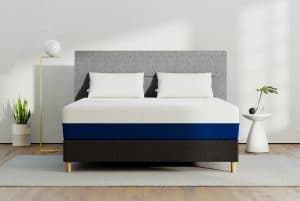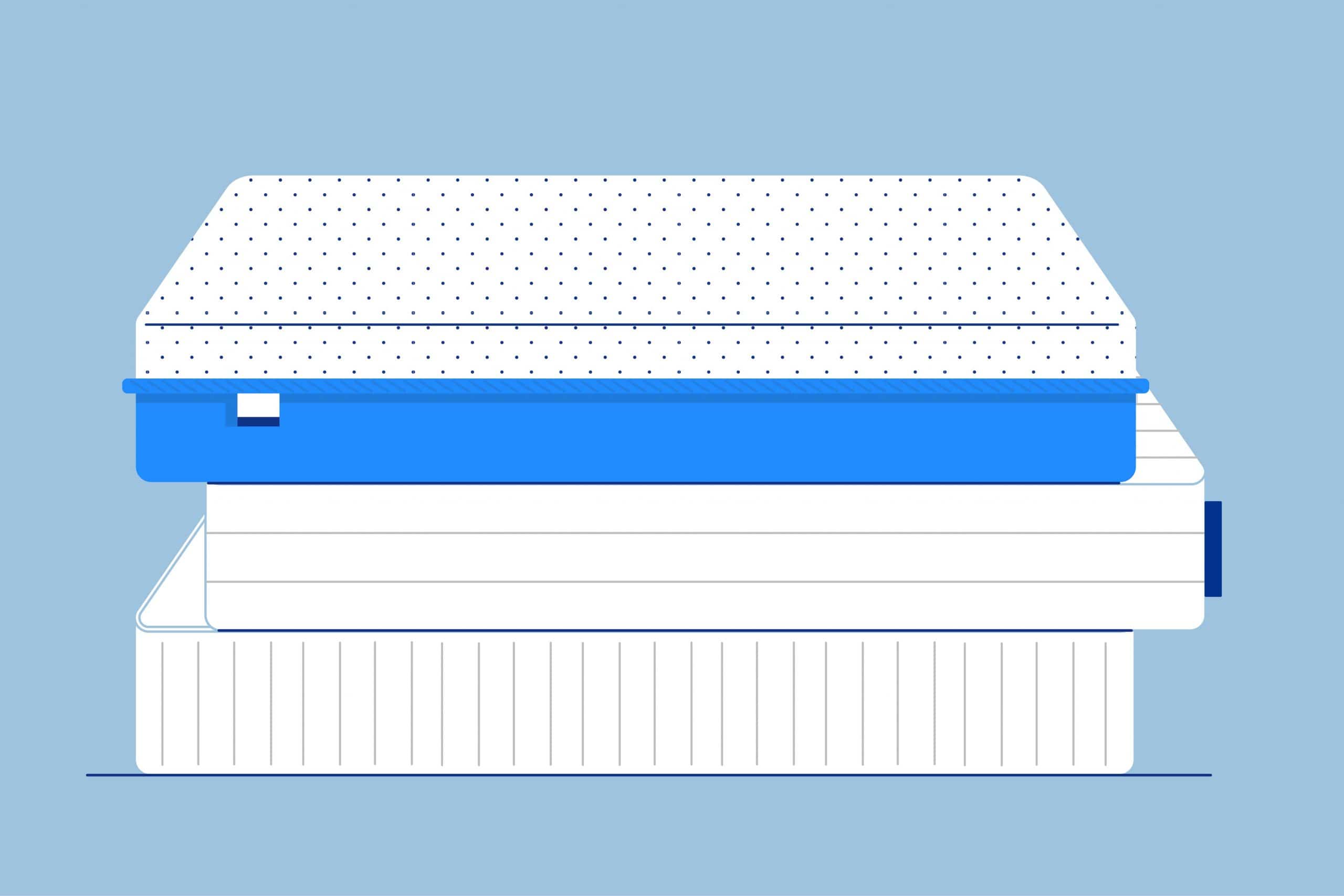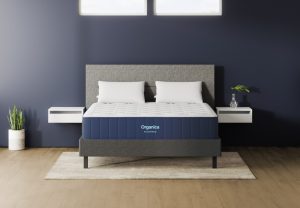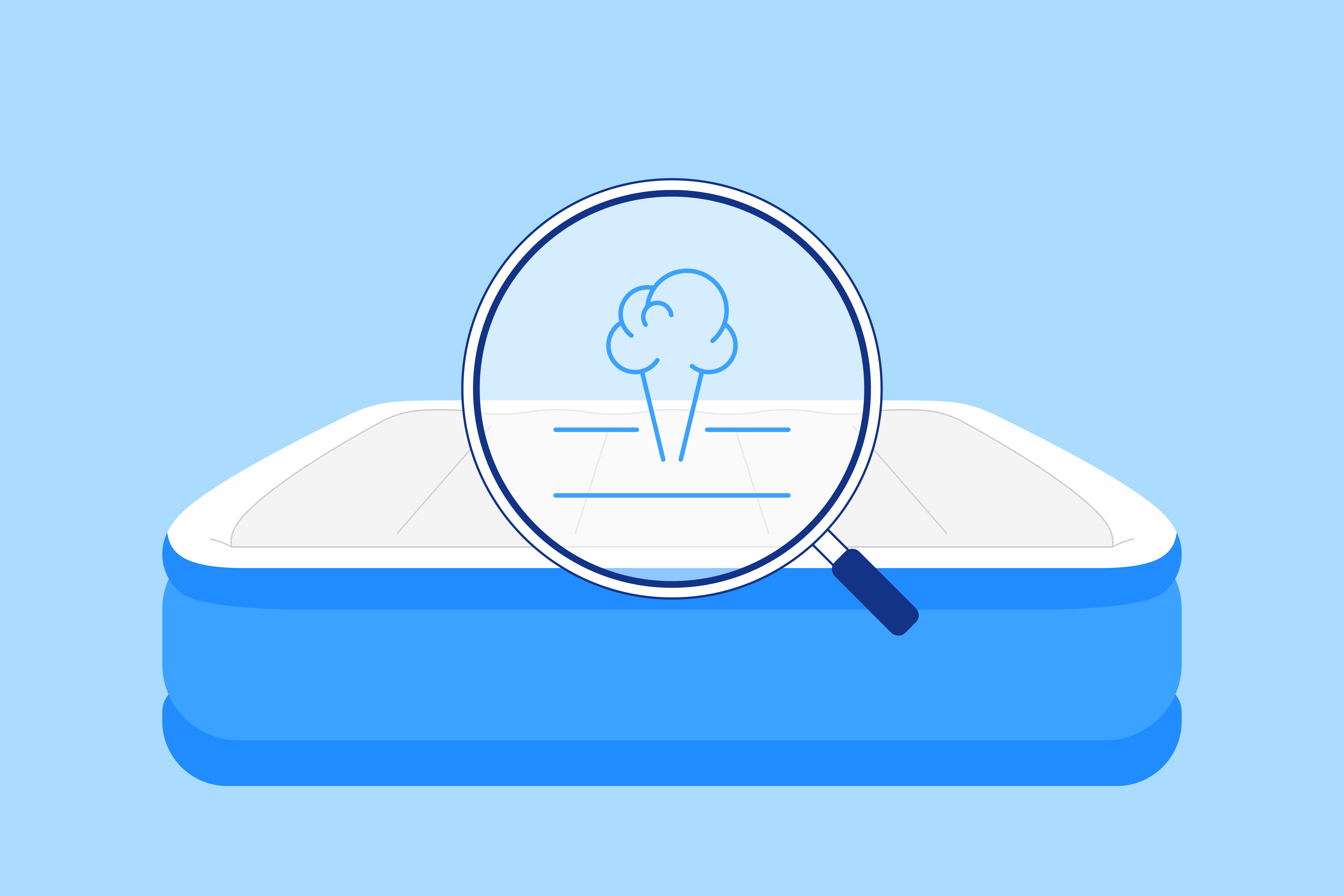Key Takeaways
- Know What Your Body Needs in a Mattress: Choose a mattress based on your sleep style and body type. Side sleepers need softer beds for pressure relief while back and stomach sleepers need more support from a firmer mattress. Your weight also impacts the feel and lifespan of a mattress.
- Understand Each One’s Benefits & Drawbacks: Know the pros and cons of each mattress type. Memory foam cradles the body but can sleep hot; latex is responsive and durable but expensive; innersprings are bouncy but lack contouring. This helps narrow your options.
- Seek Durable, Quality Materials: Look for quality materials and construction based on mattress type. For memory foam, higher density ensures durability and comfort. For innersprings, thicker coils over 1000 in count prevent sagging.
If you’re waking up with aches and pains, it may be time for a new mattress. Over the years, the mattress industry has grown and expanded the type of materials they use, creating more varieties. In our article, we outline each mattress type and offer a guide on what to look for in finding the best mattress.
Types of Mattresses
Every mattress type offers its own feel, which some sleepers may prefer over the other. Memory foam, for instance, has a hug-like feel, while innersprings provide more bounce.
Memory Foam Mattresses
 Memory foam, also known as viscoelastic foam, is polyurethane foam treated with chemicals to create a foam with more viscosity. Memory foam softens under heat and pressure to conform to the body’s natural curves for pressure point relief. It also has excellent motion isolation, so you’re less likely to wake from movement.
Memory foam, also known as viscoelastic foam, is polyurethane foam treated with chemicals to create a foam with more viscosity. Memory foam softens under heat and pressure to conform to the body’s natural curves for pressure point relief. It also has excellent motion isolation, so you’re less likely to wake from movement.
A significant drawback of traditional memory foam is its heat retention—it’s dense structure restricts air passage, making the material less breathable. Since its mattress debut in the 90s, manufacturers incorporate cooling features, like plant oils, gel, and copper or graphite.
Types of Memory Foam
Plant-Based Foam
Plant oil partially replaces petroleum during the manufacturing process, resulting in a breathable, more responsive memory foam.
Gel Memory Foam
Gel is swirled or mixed in, or gel beads are added. Gel absorbs and disperses body heat while maintaining the same feel as traditional memory foam.
Copper and Graphite Infusions
Copper and graphite are natural heat conductors. Copper draws heat away and may improve local blood flow. Graphite pulls heat away from the body and is traditionally used to cool high-powered machines, like PCs.
Quality
To find a high-quality memory foam mattress, look at the ILD rating and density. ILD—Indentation Load Deflection—measures how much pressure it takes to make a 4-inch indentation on a foam surface. The lower the number, the softer the foam. Most memory foam mattresses vary between 8 to 20.
- Extremely soft: 8 to 10
- Very soft: 11 to 15
- Soft: 16 to 21
Density determines how the foam supports the body and is measured by pounds per cubic foot (PCF)—the lower the measurement, the softer the density. Low-density foams are commonly found in the comfort layer, while high-density foams are usually in the support layer, depending on the brand.
| Memory Foam | Poly-foam |
|---|---|
| Low: 2.5 PCF to 3.9 PCF | Low: 1.8 PCF and lower |
| Medium: 4.0 PCF to 5.4 PCF | Medium: 1.8 PCF to 2.5 PCF |
| High: 5.5 PCF and higher | High: 2.5 PCF and higher |
Hybrid Mattresses
 Hybrid mattresses combine pressure-relieving memory foam or latex with the bounciness of pocketed coils to create the “perfect” bed. The idea behind the hybrid was to create a mattress that included all the benefits from two different mattresses.
Hybrid mattresses combine pressure-relieving memory foam or latex with the bounciness of pocketed coils to create the “perfect” bed. The idea behind the hybrid was to create a mattress that included all the benefits from two different mattresses.
Many manufacturers try to pass off a foam or innerspring bed as a hybrid mattress, but a true hybrid will contain a comfort layer at least 2 inches thick of either memory foam or latex and a support layer of pocketed coils.
While they include perks from both mattress types, they also come with drawbacks, including overheating, less pressure relief, and motion transfer. Hybrid mattresses are also heavy and expensive due to the number of materials they contain.
Quality
To determine a quality hybrid mattress, take a look at both ILD rating and density from the top layer and coil count and gauge from the support layer.
 Latex Mattresses
Latex Mattresses
Latex foam is similar to memory foam—both share conforming properties and isolate motion. Unlike memory foam, latex mattresses don’t form as close to the body, making it cooler, and also has a responsive bounce, so sleepers are less likely to feel stuck inside the mattress.
Latex mattresses are heavy and may be difficult to move. Also, depending on what type of latex the bed contains, latex mattresses can be expensive. There are two types of latex: natural and synthetic.
Natural Latex
Natural latex is made from rubber tree sap and created one of two ways—the Dunlop or Talalay method. Both methods involve whipping rubber tree sap into a froth and baking it at a specific temperature Still, the process varies slightly to produce latex with a different feel and texture. Latex is a popular option amongst those seeking an eco-friendly mattress.
Dunlop
Made from 100% natural latex, Dunlop is firmer and denser than Talalay latex.
Talalay
Talalay latex contains natural latex plus polyurethane fillers to create its signature soft, sponge-like feel.
Synthetic Latex
Synthetic latex is created through a chemical process and has a higher-potential of off-gassing than natural latex. Because it doesn’t contain any natural components, synthetic latex is less expensive than natural latex.
Quality
For a quality latex mattress (whether natural or synthetic), check out ILD rating and density—they’re the same as memory foam and apply to Dunlop and Talalay latex.
Innerspring Mattresses

Traditional innerspring mattresses are commonly found in households. They consist of a steel coil support system with a thin pillow top made of foam or fiberfill as a comfort layer. Innerspring mattresses provide bounce, edge support, plus cooling through its open internal structure.
Some drawbacks to innerspring mattresses include little to no pressure relief, motion transfer, and pre-mature sagging from coil breakdown. Adding a mattress topper may provide better pressure point relief, but for potential shoppers looking for a pain-free night, a memory foam or latex mattress might be better. Coil mattresses may contain Bonnell, offset, continuous, or pocketed coils.
Types of Coils
Bonnell
Spiral-shaped coils are thinner in the middle for soft pressure and thicker at the ends for firmer support.
Offset
Individual coils linked together for better conformity and a firmer feel.
Continuous
A single wire is twisted to form hundreds of individual coils. More supportive than Bonnell coils, because continuous coils act as a singular unit.
Pocketed
Individually-wrapped Bonnell coils reduce motion transfer and give overall body support.
Quality
If you’re looking for an innerspring mattress, pay attention to coil gauge and count. Coil gauge is the thickness of an innerspring coil and is measured in millimeters—the lower the measurement, the thicker the coil. Thicker coils offer firmer support, and thinner coils provide softer support.
- Thickest: 12mm
- Thinnest: 18mm
Coil count refers to the number of coils in a single layer, ranging between 500 to over 1,000 coils. Innerspring mattresses containing 300 coils or less should be avoided—they’re more likely to break down within a year.
Look at both gauge and count before committing to an innerspring mattress. A mattress containing 2,000 coils may seem like high-quality, but if those coils all have a high gauge, there’s a higher risk of sagging.
Pillow Top Mattresses
Pillow top mattresses are coil mattresses—such as innerspring or hybrid beds—with a top layer of padding sewn onto the bad (called a pillow top). Plain innerspring mattresses are firm, so they can be uncomfortable and stiff, but the pillow top adds needed pressure relief and cushioning.
Pillow tops are generally at least 1 or 2 inches thick and made from materials such as cotton, wool, or down. However, a common complaint with pillow tops is they shift in place and grow lumpy or flat.
Air Bed Mattresses
Both air beds and air mattresses use air as the prime source for both comfort and support, but they are not one-in-the-same. Air beds contain 1 to 6 air chambers, depending on bed size—some models may include a foam or latex top layer for added pressure relief. Air beds are customizable—comfort and support depend on the amount of air inside each chamber(s).
Air mattresses are convenient and portable. They’re are meant for temporary use only, like for guests and campouts.
Waterbed
Waterbeds were a popular sleep option back in the 60s and 70s and are still available today. Waterbeds, like air mattresses, use a single element for both comfort and support—this type of bed uses water. Waterbeds are also customizable, depending on the amount of water they contain. Water contours to the body’s curves and evenly distributes weight across the surface.
Waterbeds are available in three forms: free-flow, semi-waveless, and waveless. Free-flow has no restrictions, and sleepers can feel the full motion of water during sleep. Semi-waveless partially restricts motion with foam bolsters and baffles. Waveless has no motion and feels similar to a regular mattress.
Waterbeds may last longer than air mattresses, but they’re not as durable as regular beds. Waterbeds require more maintenance—checking the water level, scanning for leaks, and cleaning the water. While waterbeds contour to the body, they’re not as effective as memory foam or latex mattresses.
Futon Mattresses
Futons are Japanese-style beds, known for their simplicity. Futons are perfect options for single adults living in studio bedroom apartments. A drawback to a futon is their lack of durability.
In essence, the average futon lasts between 3 to 6 years, less than a regular mattress, and is usually built to accommodate one sleeper, not two. There are two styles of futons: Japanese and American.
Japanese
Japanese, or traditional-style, futons comprise of a thin mattress laid directly on the floor and easily rolled up for storage. Japanese futons embrace the Japanese lifestyle of simplicity and minimalism.
American
The American version consists of three parts—mattress, frame, and cover. American futons are slightly thicker and made from foam, springs, cotton, or a combination of several materials, and can either be placed directly on the floor or a foundation or frame. American futons are more versatile than the Japanese version since the futon acts as both a bed and a sofa.
Are Some Types of Mattresses Thicker Than Others?
Yes, mattresses do come in a variety of thicknesses. Mattress thickness typically ranges from 6 inches to 16 inches or more. The most common mattress thicknesses are:
- 6-8 inches – Considered thin. Often used for bunk beds, cribs, or very firm budget mattresses.
- 10-12 inches – Average/standard thickness for most mattresses. Provides a balance of comfort and support.
- 13-16 inches – A thicker mattress. Usually has more padding and materials for enhanced comfort. Common in pillow tops and luxury models.
- 18+ inches – Extra thick mattresses. Have substantial padding and sinkage. Mostly specialty beds like some memory foam, latex, or hybrid models.
Mattress type can impact thickness as well. For example, memory foam beds tend to be thicker with more foam layers, while innerspring and latex beds may be thinner.
Cost and quality also sometimes correlate with thickness, as thicker mattresses allow for more materials and engineering. But a high price tag doesn’t always equal more thickness or better performance.
Shoppers should take into account their own preferences for firmness, desired features, and ideal mattress height when choosing thickness. Testing mattresses firsthand can help determine the most suitable depth.
What are Mattresses in a Box?
Bed in a box mattresses are an all-encompassing title for mattresses sold online. This can include memory foam, hybrid, and latex mattresses, among others. Bed in a box mattresses are vacuum-sealed and rolled into a small box, making transporting and shipping easier.
Mattresses sold online are often more affordable than mattresses of the same quality sold in-store. This is thanks to the lack of overhead costs, including paying rent, bills, and employees.
Types of Sleepers
Potential shoppers shouldn’t choose a mattress based on popularity—instead, select a new bed based on your sleeping position, body weight, and if you sleep hot, suffer from medical conditions (like back pain, scoliosis, hip pain, or allergies), and if you’re part of a couple.
Sleeping Positions
Each sleep position requires a specific level of comfort and support. For example, side sleepers need extra cushioning in the shoulder and hip areas and should look for a softer surface.
Side Sleeping
Side sleeping is the healthiest sleep position, enabling better breathing, reducing acid reflux, and improving heart health. Placing a pillow between the knees prevents misalignment.
We recommend soft and medium mattresses for side sleepers since these beds provide maximum pressure point relief in the shoulders and hips.
Back Sleeping
Back sleeping naturally aligns the spine because the mattress forms up against the spine. Back sleeping increases snoring potential and may increase the risk of developing sleep apnea.
Back sleepers feel most comfortable on a medium to firm surface to cradle the hips and provide enhanced lower back support.
Stomach Sleeping
Stomach sleeping is the least healthy sleeping position due to the amount of pressure on the spine. This pressure can lead to neck strain and back pain—placing a thin pillow under the hips may alleviate pressure.
Stomach sleepers find the best comfort in a medium-firm to firm bed, keeping the body on top and preventing deep sinkage.
Combination Sleeping
Combination, or restless sleepers, toss and turn, switching between 2 to 3 sleep positions regularly. Combination sleeping may reduce acid reflux and naturally align the spine, but it can also cause snoring and back pain.
The best mattresses for combination sleepers are medium in firmness to maintain spinal alignment, no matter the sleep position.
Body Weight
Body weight determines how much cushion and support you need to keep the spine in alignment. For instance, a firmer surface may feel too hard for a light sleeper, but for a plus-size sleeper, it provides plenty of comfort and support without the risk of sagging.
Light
Lightweight sleepers weigh less than 130 pounds. They need a softer surface to enable body-contouring, pressure relief.
Average
Average weight sleepers weigh between 130 and 230 pounds. They require a medium feel for a balance of comfort and support.
Plus-Size
Plus-size sleepers weigh more than 230 pounds and need a firmer mattress to provide support without sagging.
Hot Sleepers
Hot sleepers naturally run hot or retain more heat (a.k.a. plus-size sleepers) and should look for a mattress with cooling features, natural materials (organic cotton, natural latex), breathable foams (plant-based memory foam), and open structures (steel coils).
Back Pain
National Library of Medicine studies Verified Source National Library of Medicine (NIH) World’s largest medical library, making biomedical data and information more accessible. View source have found the best mattresses for back pain are medium-firm. These beds support the spine without risk of sagging. A softer surface could escalate back pain and make it harder to sleep. Also, look for a bed with cooling features—cooling properties pull heat away and may reduce inflammation.Allergy-Prone
Some mattress types accumulate allergens and dust mites more than others, like innersprings and hybrids. Mattresses containing hypoallergenic materials, like memory foam and latex, won’t aggravate allergies and may ensure fewer sleep disruptions from nasal congestion.
Couples
One of the main issues couples face is sleep disruptions from sleep partner movement. A mattress with excellent motion isolation (a.k.a. memory foam or latex) is an ideal option. Hybrids are good mattresses for couples since thick foam layers restrict motion.
Another issue is sleeping preferences—it’s rare for couples to share the same sleep preferences, but choosing split mattress options could be the solution. Split mattresses are two mattresses placed side by side made from different materials and with different firmness levels. An adjustable base is the perfect foundation. Adjustable beds allow sleepers to elevate the head and leg areas without disturbing your sleep partner. Check with the manufacturer to make sure your mattress is compatible with an adjustable base.
Sleep Trials, Return Policies, and Mattress Warranties
Perks like sleep trials, return policies, and warranties reassure customers of a quality purchase and ensure the mattress lasts.
Sleep Trial
A sleep trial allows customers to try a new mattress within the comfort of their own home. Sleep trials last between 90 to 120 nights—some companies require customers to keep the bed at least 30 days for a mattress break-in period.
If the customer doesn’t like the mattress or if the new mattress gives them back pain, most mattress companies will pick up and donate the bed to a local charity before issuing a full refund.
Return Policy
A return policy is a good substitute if a sleep trial isn’t offered. Return policies last up to 30 days—about the time it may take for the body to adjust to a new sleep surface. Should the customer not like the mattress, they can return it for a refund.
Warranty
A warranty protects a new bed from any manufacturing defects, which could damage the bed and sagging greater than 1 inch, depending on the company. How long a mattress lasts is tied with the warranty. High-quality mattresses last between 7 to 9 years—most beds come with a standard 10-year warranty and only applies to the original purchaser.
FAQs
Which is better, a foam or spring mattress?
Both foam and spring mattresses have their benefits, so choosing between the two depends on what you need from a bed. Foam mattresses are pressure-relieving, quiet, and luxurious. Spring mattresses are supportive, breathable, and bouncy.
If you tend to overheat while sleeping, a spring mattress may be the right choice for you. If you struggle with joint or muscle pain, it might be better to get a foam mattress.
How much should I pay for a mattress?
Mattress price depends on the type of mattress you choose. Mattresses are made with a variety of materials—some better than others—but you can still find high-quality mattresses at reasonable prices.
Here are the price ranges for the following types of beds:
- Memory foam: $500 to $1500
- Hybrid: $1000 to $2000
- Latex: $1000 to $2500
- Innerspring: $500 to $1200
- Pillow top: $800 to $1400
- Air bed: $50 to $400
- Waterbed: $50 to $2000
- Futon: $250 to $1000
- Mattress in a box: $750 to $1500
We recommend shopping within the mid-range of mattress prices. While there are more budget-friendly beds, they’re typically lower quality and need to be replaced soon than other options, so they don’t really save you money in the long run.
How often should I buy a new mattress?
Most mattresses last between 7 to 10 years depending on the type of mattress and how well it’s maintained. If you don’t know whether or not it’s time for a new bed, check for these signs:
- Your mattress is saggy or lumpy
- Your mattress is yellowing or discolored
- You struggle to get comfortable in bed
- You frequently wake up in pain or tired
- You’ve noticed an increase in allergy symptoms
- You sleep better in other beds
Do I need a box spring with a memory foam mattress?
No, box springs are only compatible with innerspring mattresses. Placing a memory foam mattress on a box spring can cause damage and void your mattress warranty. Instead of a box spring, memory foam mattresses are compatible with slatted foundations, solid foundations, platform beds, and adjustable beds.
Finding the Right Mattress
Before committing to a potential new mattress, consider sleeping position and body weight. Other factors, like sleeping hot, back pain, allergies, and if you’re part of a couple, are also important. Instead of choosing a popular mattress, choose the bed right for you to achieve better sleep.
About the author
Sanchita Sen is a full-time writer focusing on the sleep health and mattress industry. She is a former journalist who has written numerous articles on the healthcare sector. Some of the topics she has covered include how to lucid dream, fever dreams, melatonin for sleep, and best gel memory foam mattress. Sanchita holds a Master of Arts in Communications from Convergence Institute of Mass Media and Information Technology Studies. She is also a published author, who seeks inspiration from both real life and the world of fiction.
View all posts


 Latex Mattresses
Latex Mattresses


